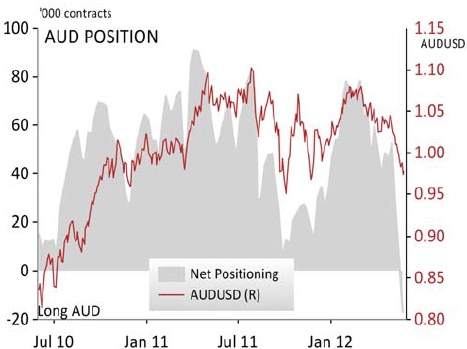Figures from the CFTC’s latest Commitment of Traders’ report also showed speculators raised their long positions in USD to the highest level in four years, as the potential fallout from a break-up of the single currency and resulting downturn in global growth drove investors towards the haven of the US currency. Figures showed International Monetary Market investors added to their short EUR positions, while pairing back their long positions, taking the net value of the bets against the single currency to an all-time high of $30.97 billion in the week to May 22.
Those positions were likely to have been extended since then, given that EURUSD has since dropped below $1.25 for the first time since July 2010.
Obviously, such extended short positioning has prompted some to speculate that the market is set up for a squeeze higher in EURUSD.
However, as EuromoneyFXNews pointed out last week, it is not clear that the rest of the market has yet followed the short-term speculative community and built up such large short positions in the EUR.
Furthermore, others say the sheer size of the problems facing the eurozone means that the criteria for judging what constitutes a crowded position have changed.
“Scope for further short EUR positioning appears limited based on the size of bearish EUR positioning relative to its history,” says Michael Sneyd, strategist at BNP Paribas.
“But given that eurozone risks could rise to unprecedented levels, past positioning provides a more limited insight into where EUR bearish positioning may peak.”
| Net short EUR position at record level |
 |
| Source: CFTC, Data Insight, Scotia FX Strategy |
Meanwhile, the net long position in the USD rose to $35.9 billion, with every currency except the CAD and GBP held short.
| Net long (short) non-commercial positions |
 |
| Source:CFTC, Scotia FX Strategy |
That meant, for the first time since March 2009, speculators abandoned their long positions in the AUD, which has been hit hard by expectations of interest-rate cuts from the Reserve Bank of Australia (RBA), fears of slowing growth in China and rising risk aversion.
Indeed, since early March, AUDUSD has dropped by 10%, helped by a 50-basis-point rate cut from the RBA and forecasts of a further 25bp move at the central bank’s next meeting on June 5.
| AUD positions turn short |
 |
| Source: CFTC, Data Insight, Scotia FX Strategy |
Given that short positions in the AUD are relatively rare, it is tempting to assume that the currency is oversold and vulnerable to a rebound.
Greg Gibbs, strategist at RBS, says while that might be true, it is also possible it indicates the market is seeing a risk that the AUD has begun a more indicative trend-change related to a weaker global economic outlook.
He says it is interesting that the market has got shorter than it was in the fourth quarter of last year, even though AUDUSD has not made a new low yet.
“This is probably a sign that the sentiment for the currency has weakened more permanently,” says Gibbs.